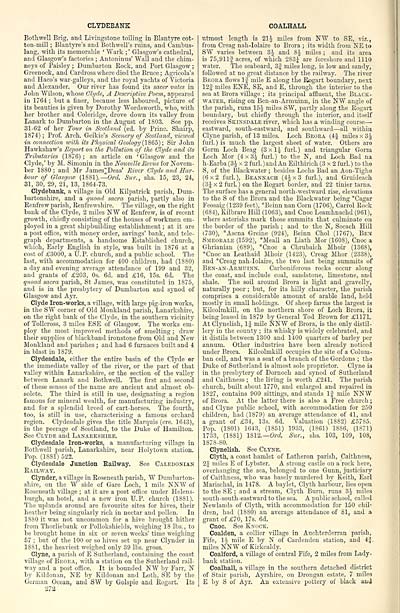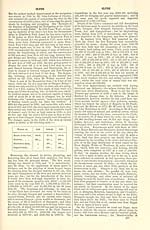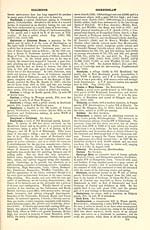Ordnance gazetteer of Scotland > Volume 1
(312) Page 272
Download files
Complete book:
Individual page:
Thumbnail gallery: Grid view | List view

CLYDEBANK
Bothwell Brig, and Livingstone toiling in Blantyre cot-
ton-mill ; Blantyre's and Bothwell's ruins, and Cambus-
lang, with its memorable ' Wark ; ' Glasgow's cathedral,
and Glasgow's factories ; Antoninus' Wall and the chim-
neys of Paisley ; Dumbarton Bock, and Port Glasgow ;
Greenock, and Cardross where died the Bruce ; Agricola's
and Haco's war-galleys, and the royal yachts of Victoria
and Alexander. Our river has found its sacer vates in
John Wilson, whose Clyde, A Descriptive Poem, appeared
in 1764 ; but a finer, because less laboured, picture of
its beauties is given by Dorothy Wordsworth, who, with
her brother and Coleridge, drove down its valley from
Lanark to Dumbarton in the August of 1803. See pp.
31-62 of her Tour in Scotland (ed. by Princ. Shairp,
1874) ; Prof. Arch. Geikie's Scenery of Scotland, viewed
in connection with its Physical Geology (1865) ; Sir John
Hawkshaw's Report on the Pollution of the Clyde and its
Tributaries (1876); an article on 'Glasgow and the
Clyde, ' by M. Simonin in the Nouvelle Revue for Novem-
ber 1880 ; and Mr Jarnes'Deas' River Clyde and Har-
bour of Glasgow (1881).— Ord. Sur., shs. 15, 23, 24,
31, 30, 29, 21, 13, 1864-73.
Clydebank, a village in Old Kilpatrick parish, Dum-
bartonshire, and a quoad sacra parish, partly also in
Renfrew parish, Renfrewshire. The village, on the right
bank of the Clyde, 2 miles NW of Renfrew, is of recent
growth, chiefly consisting of the houses of workmen em-
ployed in a great shipbuilding establishment ; at it are
a post office, with money order, savings' bank, and tele-
graph departments, a handsome Established church,
which, Early English in style, was built in 1876 at a
cost of £3000, a U.P. church, and a public school. The
last, with accommodation for 400 children, had (1880)
a day and evening average attendance of 199 and 32,
and grants of £203, 0s. 6d. and £16, 15s. 6d. The
quoad sacra parish, St James, was constituted in 1875,
and is in the presbytery of Dumbarton and synod of
Glasgow and Ayr.
Clyde Iron-works, a village, with large pig-iron works,
in the SW corner of Old Monkland parish, Lanarkshire,
on the right bank of the Clyde, in the southern vicinity
of Tollcross, 3 miles ESE of Glasgow. The works em-
ploy the most improved methods of smelting ; draw
their supplies of blackband ironstone from Old and New
Monkland and parishes ; and had 6 furnaces built and i
in blast in 1879.
Clydesdale, either the entire basin of the Clyde or
the immediate valley of the river, or the part of that
valley within Lanarkshire, or the section of the valley
between Lanark and Bothwell. The first and second
of these senses of the name are ancient and almost ob-
solete. The third is still in use, designating a region
famous for mineral wealth, for manufacturing industry,
and for a splendid breed of cart-horses. The fourth,
too, is still in use, characterising a famous orchard
region. Clydesdale gives the title Marquis (ere. 1643),
in the peerage of Scotland, to the Duke of Hamilton.
See Clyde and Lanarkshire.
Clydesdale Iron-works, a manufacturing village in
Bothwell parish, Lanarkshire, near Holytown station.
Pop. (1881)522.
Clydesdale Junction Railway. See Caledonian
Railway.
Clynder, a village in Roseneath parish, AV Dumbarton-
shire, on the W side of Gare Loch, 1 mile NNW of
Roseneath village ; at it are a post office under Helens-
burgh, an hotel, and a new iron U.P. church (1881).
The uplands around are favourite sites for hives, their
heather being singularly rich in nectar and pollen. In
1SS0 it was not uncommon for a hive brought hither
from Thorliebank or Pollokshields, weighing 18 lbs., to
be brought home in six or seven weeks' time weighing
57 ; but of the 100 or so hives set up near Clynder in
1881, the heaviest weighed only 39 lbs. gross.
Clyne, a parish of E Sutherland, containing the coast
village of Brora, with a station on the Sutherland rail-
way and a post office. It is bounded NW by Farr, N
by Kildonan, NE by Kildonan and Loth, SE by the
German Ocean, and SW by Golspie and Rogart. Its
272
COALHALL
utmost length is 21 -J miles from NW to SE, viz.,
from Creag nah-Iolaire to Brora ; its width from NE to
SW varies between 3J and 8J miles ; and its area
is 75,911| acres, of which 283J are foreshore and 1110
water. The seaboard, 3f miles long, is low and sandy,
followed at no great distance by the railway. The river
Brora flows If mile E along the Rogart boundary, next
12J miles ENE, SE, and E, through the interior to the
sea at Erora village ; its principal affluent, the Black-
water, rising on Ben-an-Armuinn, in the NW angle of
the parish, runs 15 J miles SW, partly along the Rogart
boundary, but chiefly through the interior, and itself
receives Skinsdale river, which has a winding course —
eastward, south-eastward, and southward — all within
Clyne parish, of 13 miles. Loch Brora (4f miles x 3J
furl. ) is much the largest sheet of water. Others are
Gorm Loch Beag (3xl| furl.) and triangular Gorm
Loch Mor (4x34 furl.) to the N, and Loch Bad na
h-Earba (3£ x 2 furl. ) and An Eilthirich (3x2 furl. ) to the
S, of the Blackwater ; besides Lochs Bad an Aon-Tighe
(6x2 furl.), Beannach (4^x3 furl.), and Gruideach
(3 J x 2 furl. ) on the Rogart border, and 22 tinier tarns.
The surface has a general north-westward rise, elevations
to the S of the Brora and the Blackwater being *Cagar
Feosaig (1239 feet), *Beinn nan Corn (1706), Carrol Rock
(684), Kilbrare Hill (1063), and Cnoe Leamhnaehd (961),
where asterisks mark those summits that culminate on
the border of the parish ; and to the N, Soeach Hill
(730), *Ascna Greine (924), Beinn Choi (1767), Ben
Smeorale (1592), *Meall an Liath Mor (160S), Cnoc a
Ghrianian (689), *Cnoc a Chrubaich Mhoir (1368),
*Cnoc an Leathaid Mhoir (1423), Creag Mhor (2338),
and *Creag nah-Iolaire, the two last being summits of
Ben-an-Armuinn. Carboniferous rocks occur along
the coast, and include coal, sandstone, limestone, and
shale. The soil around Brora is light and gravelly,
naturally poor ; but, for its hilly character, the parish
comprises a considerable amount of arable land, held
mostly in small holdings. Of sheep farms the largest is
Kilcolmkill, on the northern shore of Loch Brora, it
being leased in 1879 by General Tod Brown for £1171.
At Clynelish, 1 J mile NNW of Brora, is the only distil-
lery in the county ; its whisky is widely celebrated, and
it distils between 1300 and 1400 quarters of barley per
annum. Other industries have been already noticed
under Brora. Kilcolmkill occupies the site of a Colum-
ban cell, and was a seat of a branch of the Gordons ; the
Duke of Sutherland is almost sole proprietor. Clyne is
in the presbytery of Dornoch and synod of Sutherland
and Caithness ; the living is worth £241. The parish
church, built about 1770, and enlarged and repaired in
1827, contains 900 sittings, and stands If mile NNW
of Brora. At the latter there is also a Free church ;
and Clyne public school, with accommodation for 250
children, had (1879) an average attendance of 41, and
a grant ' of £34, 13s. 6d. Valuation (18S2) £5785.
Pop. (1801) 1643, (1851) 1933, (1861) 1886, (1871)
1733, (1881) 1812.— Ord Sur., shs. 103, 109, 108,
1878-80.
Clynelish. See Clyne.
Clyth, a coast hamlet of Latheron parish, Caithness,
2J miles E of Lybster. A strong castle on a rock here,
overhanging the sea, belonged to one Gunn, justiciary
of Caithness, who was basely murdered by Keith, Earl
Marischal, in 1478. A baylet, Clyth harbour, lies open
to the SE ; and a stream, Clyth Burn, runs 3J miles
south-south-eastward to the sea. A public school, called
Newlands of Clyth, with accommodation for 150 chil-
dren, had (1880) an average attendance of 81, and a
grant of £70, 17s. 6d.
Cnoc. See Knock.
Coalden, a collier village in Auchterderran parish,
Fife, 1J mile E by N of Cardenden station, and 4J
miles NNW of Kirkcaldy.
Coalford, a village of central Fife, 2 miles from Lady-
bank station.
Coalhall, a village in the southern detached district
of Stair parish, Ayrshire, on Drongan estate, 7 miles
E by S of Ayr. An extensive pottery of black and
Bothwell Brig, and Livingstone toiling in Blantyre cot-
ton-mill ; Blantyre's and Bothwell's ruins, and Cambus-
lang, with its memorable ' Wark ; ' Glasgow's cathedral,
and Glasgow's factories ; Antoninus' Wall and the chim-
neys of Paisley ; Dumbarton Bock, and Port Glasgow ;
Greenock, and Cardross where died the Bruce ; Agricola's
and Haco's war-galleys, and the royal yachts of Victoria
and Alexander. Our river has found its sacer vates in
John Wilson, whose Clyde, A Descriptive Poem, appeared
in 1764 ; but a finer, because less laboured, picture of
its beauties is given by Dorothy Wordsworth, who, with
her brother and Coleridge, drove down its valley from
Lanark to Dumbarton in the August of 1803. See pp.
31-62 of her Tour in Scotland (ed. by Princ. Shairp,
1874) ; Prof. Arch. Geikie's Scenery of Scotland, viewed
in connection with its Physical Geology (1865) ; Sir John
Hawkshaw's Report on the Pollution of the Clyde and its
Tributaries (1876); an article on 'Glasgow and the
Clyde, ' by M. Simonin in the Nouvelle Revue for Novem-
ber 1880 ; and Mr Jarnes'Deas' River Clyde and Har-
bour of Glasgow (1881).— Ord. Sur., shs. 15, 23, 24,
31, 30, 29, 21, 13, 1864-73.
Clydebank, a village in Old Kilpatrick parish, Dum-
bartonshire, and a quoad sacra parish, partly also in
Renfrew parish, Renfrewshire. The village, on the right
bank of the Clyde, 2 miles NW of Renfrew, is of recent
growth, chiefly consisting of the houses of workmen em-
ployed in a great shipbuilding establishment ; at it are
a post office, with money order, savings' bank, and tele-
graph departments, a handsome Established church,
which, Early English in style, was built in 1876 at a
cost of £3000, a U.P. church, and a public school. The
last, with accommodation for 400 children, had (1880)
a day and evening average attendance of 199 and 32,
and grants of £203, 0s. 6d. and £16, 15s. 6d. The
quoad sacra parish, St James, was constituted in 1875,
and is in the presbytery of Dumbarton and synod of
Glasgow and Ayr.
Clyde Iron-works, a village, with large pig-iron works,
in the SW corner of Old Monkland parish, Lanarkshire,
on the right bank of the Clyde, in the southern vicinity
of Tollcross, 3 miles ESE of Glasgow. The works em-
ploy the most improved methods of smelting ; draw
their supplies of blackband ironstone from Old and New
Monkland and parishes ; and had 6 furnaces built and i
in blast in 1879.
Clydesdale, either the entire basin of the Clyde or
the immediate valley of the river, or the part of that
valley within Lanarkshire, or the section of the valley
between Lanark and Bothwell. The first and second
of these senses of the name are ancient and almost ob-
solete. The third is still in use, designating a region
famous for mineral wealth, for manufacturing industry,
and for a splendid breed of cart-horses. The fourth,
too, is still in use, characterising a famous orchard
region. Clydesdale gives the title Marquis (ere. 1643),
in the peerage of Scotland, to the Duke of Hamilton.
See Clyde and Lanarkshire.
Clydesdale Iron-works, a manufacturing village in
Bothwell parish, Lanarkshire, near Holytown station.
Pop. (1881)522.
Clydesdale Junction Railway. See Caledonian
Railway.
Clynder, a village in Roseneath parish, AV Dumbarton-
shire, on the W side of Gare Loch, 1 mile NNW of
Roseneath village ; at it are a post office under Helens-
burgh, an hotel, and a new iron U.P. church (1881).
The uplands around are favourite sites for hives, their
heather being singularly rich in nectar and pollen. In
1SS0 it was not uncommon for a hive brought hither
from Thorliebank or Pollokshields, weighing 18 lbs., to
be brought home in six or seven weeks' time weighing
57 ; but of the 100 or so hives set up near Clynder in
1881, the heaviest weighed only 39 lbs. gross.
Clyne, a parish of E Sutherland, containing the coast
village of Brora, with a station on the Sutherland rail-
way and a post office. It is bounded NW by Farr, N
by Kildonan, NE by Kildonan and Loth, SE by the
German Ocean, and SW by Golspie and Rogart. Its
272
COALHALL
utmost length is 21 -J miles from NW to SE, viz.,
from Creag nah-Iolaire to Brora ; its width from NE to
SW varies between 3J and 8J miles ; and its area
is 75,911| acres, of which 283J are foreshore and 1110
water. The seaboard, 3f miles long, is low and sandy,
followed at no great distance by the railway. The river
Brora flows If mile E along the Rogart boundary, next
12J miles ENE, SE, and E, through the interior to the
sea at Erora village ; its principal affluent, the Black-
water, rising on Ben-an-Armuinn, in the NW angle of
the parish, runs 15 J miles SW, partly along the Rogart
boundary, but chiefly through the interior, and itself
receives Skinsdale river, which has a winding course —
eastward, south-eastward, and southward — all within
Clyne parish, of 13 miles. Loch Brora (4f miles x 3J
furl. ) is much the largest sheet of water. Others are
Gorm Loch Beag (3xl| furl.) and triangular Gorm
Loch Mor (4x34 furl.) to the N, and Loch Bad na
h-Earba (3£ x 2 furl. ) and An Eilthirich (3x2 furl. ) to the
S, of the Blackwater ; besides Lochs Bad an Aon-Tighe
(6x2 furl.), Beannach (4^x3 furl.), and Gruideach
(3 J x 2 furl. ) on the Rogart border, and 22 tinier tarns.
The surface has a general north-westward rise, elevations
to the S of the Brora and the Blackwater being *Cagar
Feosaig (1239 feet), *Beinn nan Corn (1706), Carrol Rock
(684), Kilbrare Hill (1063), and Cnoe Leamhnaehd (961),
where asterisks mark those summits that culminate on
the border of the parish ; and to the N, Soeach Hill
(730), *Ascna Greine (924), Beinn Choi (1767), Ben
Smeorale (1592), *Meall an Liath Mor (160S), Cnoc a
Ghrianian (689), *Cnoc a Chrubaich Mhoir (1368),
*Cnoc an Leathaid Mhoir (1423), Creag Mhor (2338),
and *Creag nah-Iolaire, the two last being summits of
Ben-an-Armuinn. Carboniferous rocks occur along
the coast, and include coal, sandstone, limestone, and
shale. The soil around Brora is light and gravelly,
naturally poor ; but, for its hilly character, the parish
comprises a considerable amount of arable land, held
mostly in small holdings. Of sheep farms the largest is
Kilcolmkill, on the northern shore of Loch Brora, it
being leased in 1879 by General Tod Brown for £1171.
At Clynelish, 1 J mile NNW of Brora, is the only distil-
lery in the county ; its whisky is widely celebrated, and
it distils between 1300 and 1400 quarters of barley per
annum. Other industries have been already noticed
under Brora. Kilcolmkill occupies the site of a Colum-
ban cell, and was a seat of a branch of the Gordons ; the
Duke of Sutherland is almost sole proprietor. Clyne is
in the presbytery of Dornoch and synod of Sutherland
and Caithness ; the living is worth £241. The parish
church, built about 1770, and enlarged and repaired in
1827, contains 900 sittings, and stands If mile NNW
of Brora. At the latter there is also a Free church ;
and Clyne public school, with accommodation for 250
children, had (1879) an average attendance of 41, and
a grant ' of £34, 13s. 6d. Valuation (18S2) £5785.
Pop. (1801) 1643, (1851) 1933, (1861) 1886, (1871)
1733, (1881) 1812.— Ord Sur., shs. 103, 109, 108,
1878-80.
Clynelish. See Clyne.
Clyth, a coast hamlet of Latheron parish, Caithness,
2J miles E of Lybster. A strong castle on a rock here,
overhanging the sea, belonged to one Gunn, justiciary
of Caithness, who was basely murdered by Keith, Earl
Marischal, in 1478. A baylet, Clyth harbour, lies open
to the SE ; and a stream, Clyth Burn, runs 3J miles
south-south-eastward to the sea. A public school, called
Newlands of Clyth, with accommodation for 150 chil-
dren, had (1880) an average attendance of 81, and a
grant of £70, 17s. 6d.
Cnoc. See Knock.
Coalden, a collier village in Auchterderran parish,
Fife, 1J mile E by N of Cardenden station, and 4J
miles NNW of Kirkcaldy.
Coalford, a village of central Fife, 2 miles from Lady-
bank station.
Coalhall, a village in the southern detached district
of Stair parish, Ayrshire, on Drongan estate, 7 miles
E by S of Ayr. An extensive pottery of black and
Set display mode to: Large image | Transcription
Images and transcriptions on this page, including medium image downloads, may be used under the Creative Commons Attribution 4.0 International Licence unless otherwise stated. ![]()
| Gazetteers of Scotland, 1803-1901 > Ordnance gazetteer of Scotland > Volume 1 > (312) Page 272 |
|---|
| Permanent URL | https://digital.nls.uk/97372510 |
|---|
| Attribution and copyright: |
|
|---|---|

